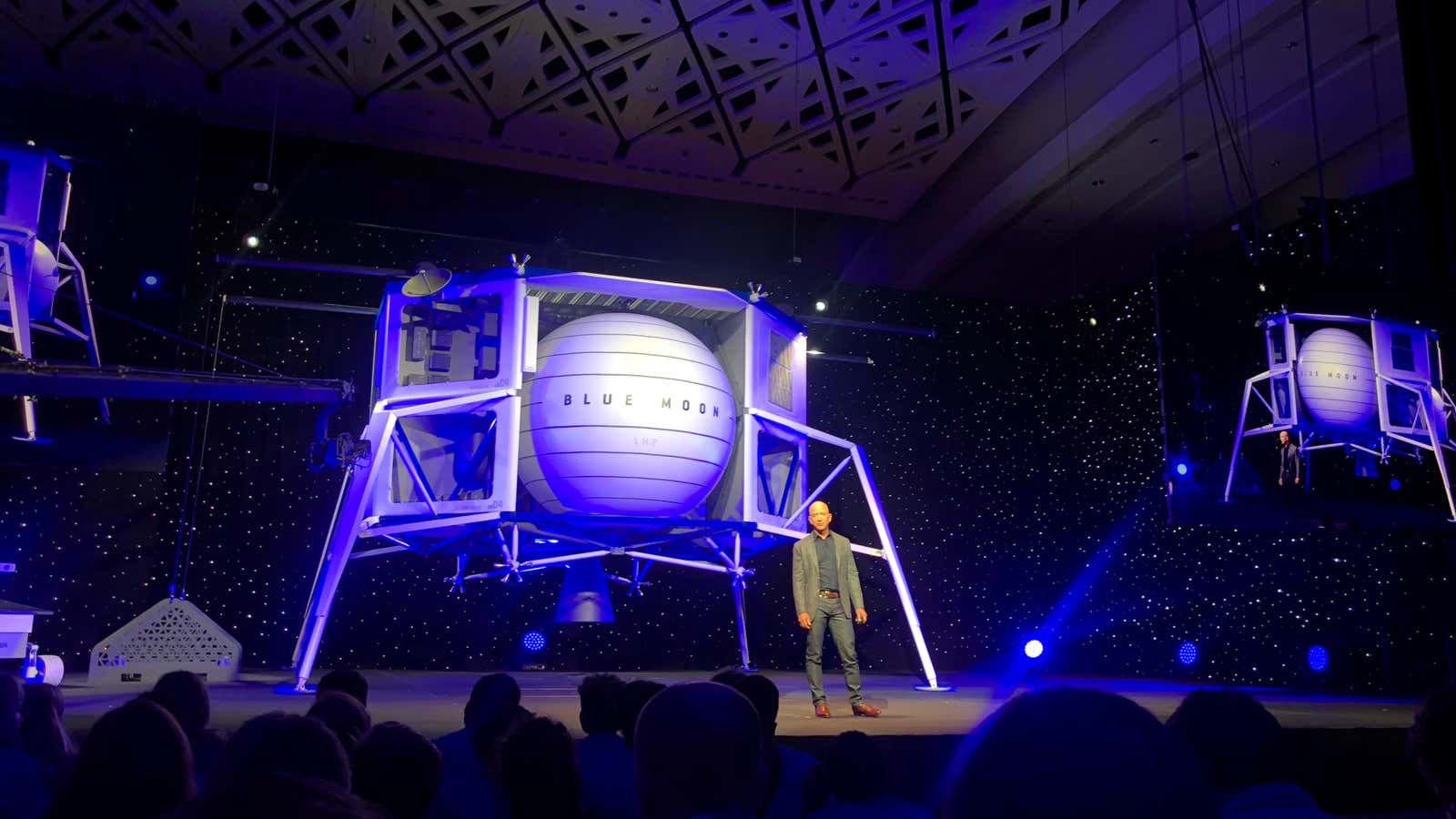Jeff Bezos today unveiled a lunar lander designed by his company Blue Origin, another step toward the billionaire entrepreneur’s goal of creating the infrastructure for millions of people to live and work in space.
Bezos said the enormous lunar lander could deliver 6.5 metric tons (7.1 tons) to the surface of the Moon. He didn’t set a date for a mission, but said that the engine for the lander will be tested this summer, and that the vehicle could be upgraded to carry humans as part of NASA’s push to return to the Moon by 2024.
Bezos, who started Blue Origin in 2000 with the wealth generated by Amazon, has long advocated for more human activity in space, but this marks his most comprehensive attempt to explain and justify what he has called his most important project.
Bezos framed the mission as a way to save the Earth, which he called our “best planet.” Though stressing the need to address near-term problems like poverty and pollution, Bezos argued that in the long-term the Earth is in danger of running out energy, an idea he has discussed before.
Bezos says that in 200 years, humanity would need to cover the Earth in solar cells to meet human energy demand, which he says doubles every 25 years. Blue Origin has never shared the sources of his claims, and no one from the company took questions from the press.
“The Earth is no longer big,” Bezos told an audience of schoolchildren, reporters, Blue Origin employees, and space industry representatives. “Humanity is big.”
In his speech, Bezos painted a picture of a “bad path” for Earth, of energy rationing and falling prosperity. But if humanity moves into the solar system, he said, there could be nearly unlimited energy from solar power. “This is an easy choice. We know what we want, we just have to get busy.”
Blue Origin has long considered itself an understated alternative to competitor SpaceX and its flamboyant founder, Elon Musk. The biggest difference between Bezos’s and Musk’s visions is that the former doesn’t believe in a multi-planetary society, as Musk does with the colonization of Mars.
Bezos believes instead in orbital space habitats—manufactured planets—akin to the International Space Station but many thousands of times bigger. He imagines these habitats replicating historical Earth cities or creating artificial climates—”Maui on its best day, all year long.”
But the two men agree on one key point: the need to drive down the cost of access to space with reusable rockets and the exploitation of space resources. “The price of admission to do interesting things in space right now is just too high,” Bezos said.
So far, his team has developed a reusable suborbital rocket called the New Shepard that first flew in 2015 and has since taken flight 11 times. It is used to fly scientific experiments and will eventually be able to shuttle human passengers who will pay to rocket past the edge of space and enjoy a few minutes in free fall. More important for lunar activities, Blue Origin is developing a larger orbital rocket, New Glenn, expected to debut in 2021.
In 2017, Blue CEO Bob Smith told me that Amazon’s lunar plans were waiting for NASA funding. Now, in the 50th year since the first astronauts landed on the Moon, the US space program has become intensely focused on a return to the Moon and the potential to harvest water ice there to make longer and more productive activities in space possible. NASA has also announced a program to pay private companies to carry scientific missions to the Moon.
This year, US vice president Mike Pence unveiled a goal of returning American astronauts to the Moon as soon as 2024. “We can help meet that timeline, but only because we started three years ago,” Bezos said today, calling the Moon “a gift” because of its proximity and the potential for mining water ice.
Today’s event was previewed when Blue posted a picture of the Endurance, a ship used in a 1914 Antarctic expedition by the explorer Ernest Shackleton. Shackleton became a legend for bringing his crew back alive after ice captured the Endurance, and now there is a crater named for him on the Moon’s south pole—one widely seen by lunar experts as worth exploring.
Blue is also designing an engine for use in a new rocket being built by United Launch Alliance, the Lockheed Martin and Boeing joint venture, and bidding to fly national security satellites for the US government.
